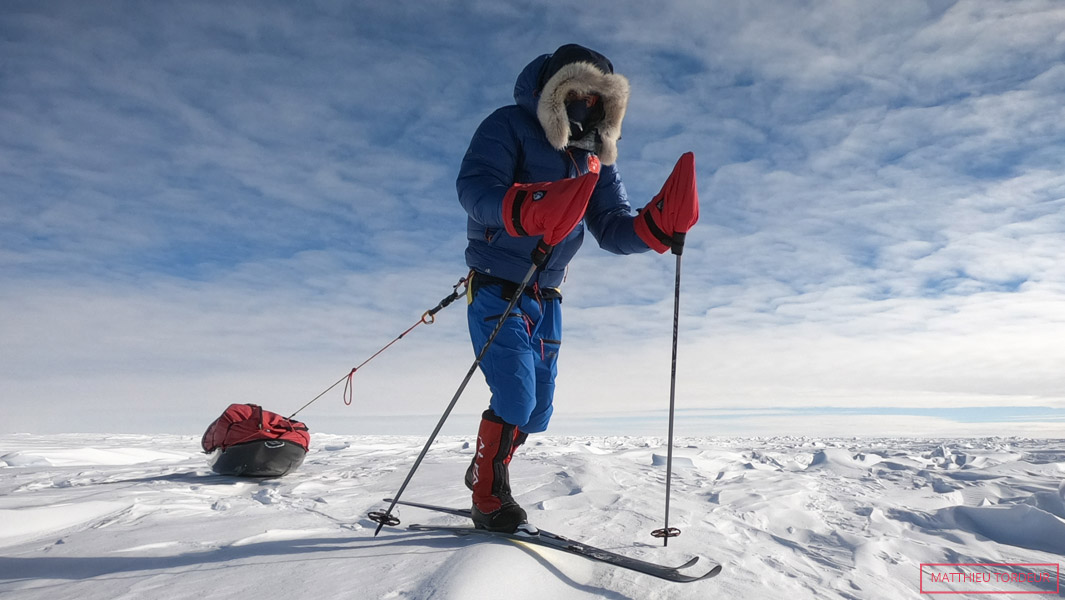Explorer becomes youngest person to reach the South Pole on their own after 51-day trek across Antarctica

When you hear about someone going to the South Pole on their own, so many questions come to mind: what was it like; how did they prepare; why?
Aged 27 years 40 days Matthieu Tordeur is now the youngest person to reach South Pole solo, unsupported and unassisted after a 51-day expedition across Antarctica from Hercules Inlet. That's a distance of 1,130 km (702 miles) in temperatures reaching as low as -30C.
As this year’s Guinness World Records Day is themed "Spirit of Adventure", Matthieu’s achievement fits perfectly with the theme so we decided to ask him those questions to find out more about his journey.
Learn about more record-breaking exploits in the Spirit of Adventure chapter in Guinness World Records 2020
The young adventurer had no idea he was eligible for any world records, he just really wanted to walk to the South Pole!
When asked about his inspirations, Matthieu said: "People like Ranulph Fiennes, Ben Saunders, and for the French, Jean-Louis Étienne who was the first man to reach the North Pole solo in 1986.
"These guys fascinated me for ages and one day I just thought 'I could try to do a similar expedition' and there I went!"

Matthieu’s Antarctica expedition was unsupported and unassisted, but what does that actually mean?
Unassisted means Matthieu didn’t have any help physically during his journey from Hercules Inlet, a common starting point on the western side of Antarctica for journeys to the South Pole.
"I didn’t use any kind of kite to propel myself or any dogs to reach the South Pole, I was skiing all the way," he explained.

On these kinds of long-haul sub-zero journeys, the most common and practical mode of transport is to walk with skis on.
As for being unsupported, Matthieu didn’t receive any help with supplies like food or keeping warm.
“It was just me and Antarctica,” he recalled as he was completely alone until he reached the pole.
Matthieu dedicated two years to several practice expeditions before his trip to Antarctica where he camped in places like Greenland and Svalbard, a small archipelago off the coast of Norway.
"I trained in real conditions, in the arctic where I was dragging a sled and camping in frozen temperatures. It takes a lot of dedication and time to train for such an adventure."
He even took part in the annual Marathon des Sables, an event that consists of a 250 km course through the Sahara Desert where participants have to carry all their supplies in backpacks.
This is similar to what Matthieu needed to do in Antarctica where he dragged a giant sled along the ice with 115 kg's worth of equipment.
Most of that weight was the huge amount of food Matthieu had to carry for himself which was made up of things like "chocolate and dehydrated energy snacks".
More than seven weeks alone in the snow does sound brutal, so being able to cope with the conditions and loneliness is important.
While some of it was down to distracting himself by listening to music and various podcasts, Matthieu also showed a lot of mental resilience.
"I was thinking about future plans and projects. It's such a beautiful place that boredom and loneliness just pass."
He was also able to keep in touch with friends and family by sending daily updates of his whereabouts, so they also shared his excitement when he finally reached the pole on 13 January 2019.
"Obviously it was the end of 51 days of walking alone, but it was also the end of two years of training and planning."

He was greeted by research scientists at Amundsen–Scott South Pole Station and took pictures by the physical South pole surrounded by several national flags, so all in all, Matthieu found himself in quite an international hotspot!
When asked if those future plans involved achieving any new record titles, Matthieu says his plate was currently a little full as he’s now writing a book about his adventures as well as having filmed a television documentary about this very expedition.

Matthieu hopes more people apply for his record: "I'm wishing for someone to creak this record because in my opinion, records are here to be broken."
His advice to anyone considering a similarly epic journey, aside from training in as many extreme climates and conditions as you can, is to ask loads of questions to those who’ve completed any expeditions of scale.
"In my experience, people were friendly and open to sharing their good practices and advice."

Read about other achievements celebrated on Guinness World Records Day:
- Real-life Iron Man smashes his jet-powered suit record by flying at 85 mph along Brighton Pier
- The woman making '60 the new 40' by becoming the oldest person to swim the 200-km Oceans Seven
- Riding the length of Japan on a scooter: why a red samurai has embarked on an 8,000-km journey
- Disabled son inspires proud dad’s record-breaking swim for Guinness World Records Day
- Adventurer rides 10,000 km across the width of China on his electric scooter
- Harlem Globetrotters set yet more records with long-distance basketball shots and even more tricks
- Brothers travel more than 3,000 miles around China by train in just 24 hours
- Doctors pedal more than 28,000 km to circumnavigate the globe on a tandem


